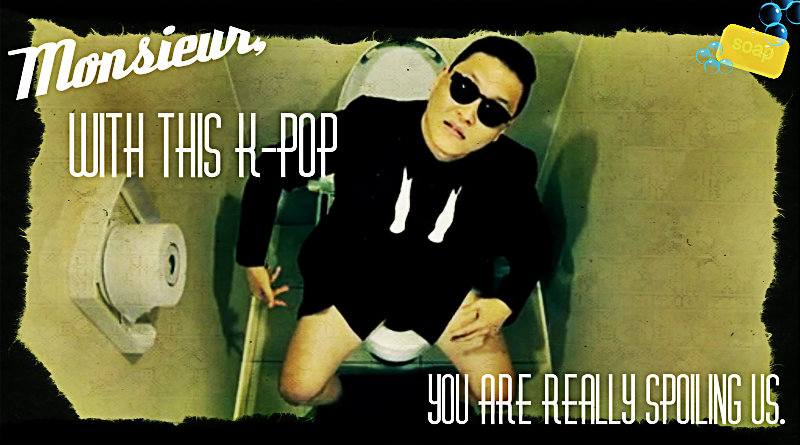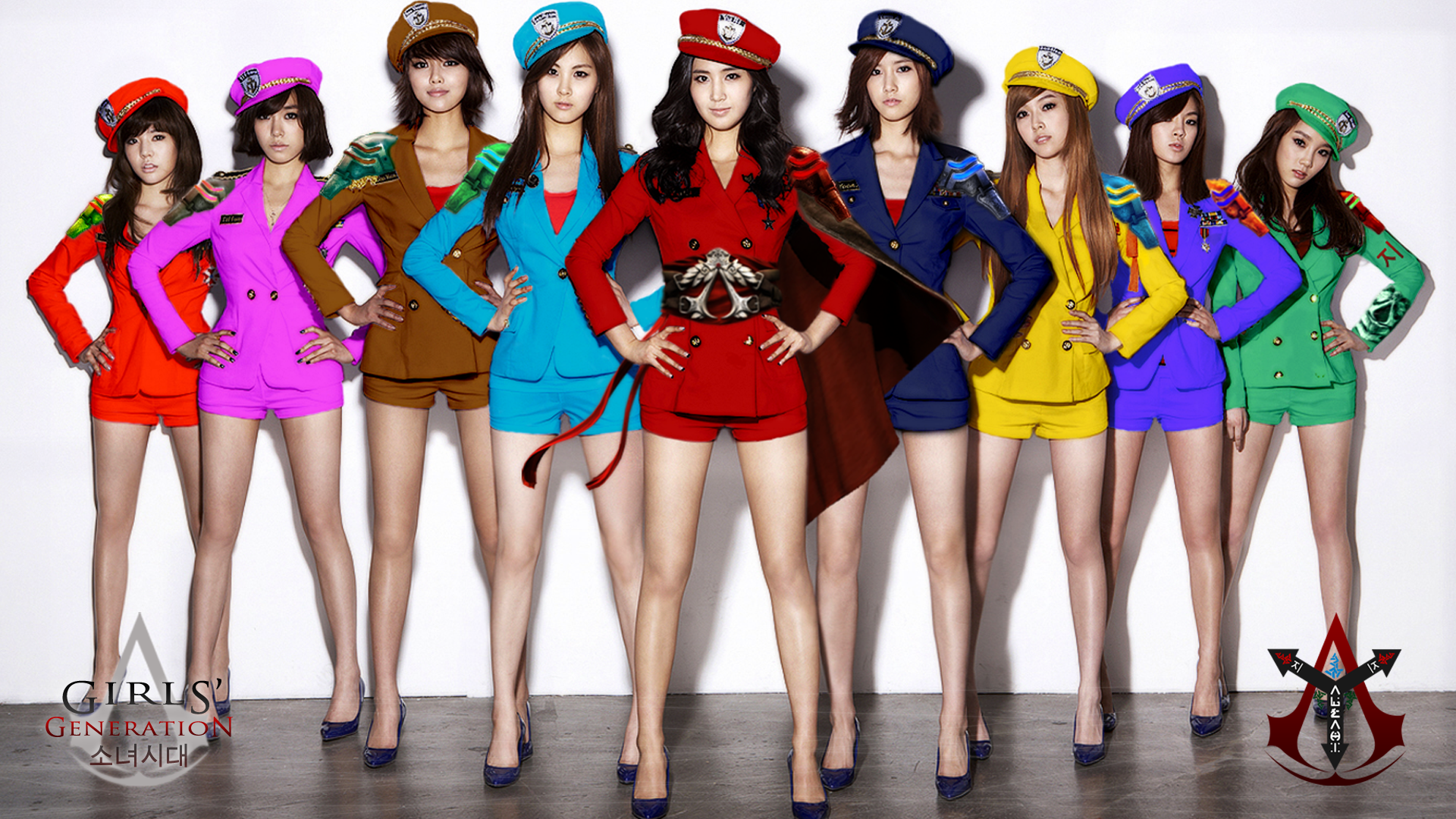by Ally Mutsmakher

Let me be the first to stand amidst a dusty street, while the townsfolk take shelter behind bartered doors, and cry: "The Asians are coming! The Asians are coming!"
Well, the "South Koreans K-pop idols are coming" more specifically but it's unlikely that these perfectly primped and made-up visitors, clad in colourful clothes and dangerously high-heeled shoes, would arouse such an unwelcoming response in their North American hosts. They are far too pretty for us to suspect of them having any ulterior political motives.
A decade ago K-pop would have been a completely foreign concept, but recently K-pop has been getting more attention in North America. Now it's very possible to meet another non-Korean Canadian with a keen interest in K-pop, whereas before attending a mostly Asian populated concert would put you in a white minority. Now even those who have no knowledge of K-pop or any other Asian culture would have been probably blasted with Psy's in-your-face music video for "Gangnam Style". The video's humour and playfulness have done the impossible: a foreign music video with a foreign theme, performed in a foerign lagnuage has proved to be universal.
I guess, humour transgresses all barriers!
Yes, the Asian Invasion of North American culture, or as it is commonly referred to by knowing K-pop lovers: hallyu. I too have fallen victim to the allures of these gloriously exotic cultures, surrounded myself with the cinema (specifically East and South Eastern horror), pop culture (manga, anime) and food (give me green curry, give me sushi and I will ask pho more), as well as annoyed others when attempting to rehearse words and dialects I picked up from friends and movies.
It started innocently when I frequented a few Korean restaurants. Next thing I know, I'm putting aside my snobbish affinities for music to explore a genre that my friends have been turning their noses from since they've started carving metal bands onto their notebooks: Pop -unbridled, saccharine and unapologetic in its frivolousness. The silly, repetitive lyrics, the catchy tunes that seep into your brain but very soon expire from your palette altogether (these are all compliments, mind you) provided a needed escape for anyone living in a society of high stress and low attention span.
In light of this new musical development on the K-Pop front, I decided to enlighten the rest of the phenomenon (how kind of me!). So this blog will chronicle and discuss themes and issues relating to K-pop: the prospect of a political conspiracy as the driving force behind this million dollar industry; the repercussions of K-pop's marketing of unattainable perfection on its audience; speculations on its appeal and the possibility of a North-American crossover; its origins and key players in the industry, and other miscellaneous things.
As my blog expands it will come to include a better variety of sources and arguments, but in the meantime, this page will serve as a primer for concepts and issues related to the wondrous phenomenon that is K-pop.
Origins
Strangely enough the introduction of Western genres of music such as Pop, Hip-Hop, R&B and Rock was the thing that propelled the birth of K-pop. Essentially, K-pop is a Korean adaptation of Western music, sung in Korean language by Korean artists. But since the early 90s, when Western music blended into the Korean music industry, a lot of purely Korean elements have been added to the mix, creating a brand new product. Yes, it still relies heavily on Western trends for musical inspiration, but the music videos and the idols themselves (as well as their producers) are responsible for their unique message and image.
K-Pop has grown to encompass almost all genres of Korean music, be it Indie, Rock, Trot (which is a genre of music that has been around for longer than K-pop, and is usually widely popular among older Koreans, but is not considered traditional Korean music), R&B, and even Hip-Hop. K-pop has simply developed to mean "Korean Music". This could be due to the poppy, bubbly quality of Korean music and videos in general. They are typified by an affinity for colour, outrageous wardrobes, hairstyle of any shape and colour, and themes and fashions which are cartoon-like in nature. K-pop, overall, tends to reflect playfulness, innocence and fun.
K-pop is also incredibly popular in other parts of Asia. For example, in China, Japan, and much of Southeast Asia, especially Indonesia, Malaysia, Thailand, and Vietnam. It is particularly popular in Japan, so much so that many are worried that J-Pop and J-Rock are becoming obsolete due to K-pop's popularity. Actually a lot of idols learn Japanese and release Japanese versions of their songs, albums and even videos (these are entirely different from their original, Korean versions, not merely translated).
Key Players
When it comes to K-pop, entertainment/ production companies are almost more important than the idols themselves. These agencies train and sculpt young idols and are almost fully responsible for their public image, their relationship with fans, their videos, music and essentially their everyday lives.
The ones that have been consistently producing successful idols and girl/ boy bands are SM Entertainment (South Korea's largest entertainment agency), DSP Entertainment, JYP Entertainment, and YG Entertainment.
Bands and idols that enjoy both Korean and (some) North American popularity are: TVXQ, Super Junior, Girl Generation, 2NE1, Rain, Big Bang (also, G-Dragon and TOP who now have a separate solo career as Hip-Hop artists), B2ST, Xiah Junsu, U-Kiss, F.T. Island, BoA, JYP, UV, Nu'est, T-ara, ZE:A, Hyuna, Psy, Tiny-G, Teen Top, and many others.
K-pop boy band TVXQ has been around for quite a while, but their popularity hasn't waned.
North American Cross-Over
Ours being a visual culture, the spread of K-pop music has arguably occurred through visual media such as cross-cultural exposure to Korean cinema and television, and most prominently the internet. Film still-shots and idol (singers/ actors) photos and biographies are widely available on the internet. A simple Google search would produce numerous pictures of K-pop idols and bands, and direct you to numerous forums dedicated to singing the praises of that particular idol/ band. Undeniably, beauty has appeal that extends beyond our culture, and is more influential on a multifaceted and culturally encompassing society such as Canada and the U.S., so pictures alone can pique interest in an especially scrumptious K-pop idol.
North American bloggers who are interested in Korean music and culture are also a driving force behind this phenomena. Some discuss the music and review the videos, generating huge debate in forums about favourite stars and starlets. Others review and introduce Korean skincare and fashion to those who live overseas through makeup tutorials and makeup reviews. Eat You Kimchi is one such website that has transformed from a small at-home blog to a powerhouse of information regarding the latest and freshest K-pop news and music releases. Currently they hold a much subscribed to YouTube channel that traffics massive views per day for each one of their witty and clever segments, like "K-Pop Music Mondays" and "K-Crunch Indie".
YouTube is probably the main culprit behind this new and exciting interest in Korean music videos (MVs). The reason terms like viral are often attributed to K-pop videos, or any videos in general, is because videos which are so widely and freely available to anyone with internet access, have the ability to capture the immediate attention of international audiences. K-pop bands and idols, as well as production companies, usually have a well-maintained website and their own official YouTube channel where they post newly released MVs , interviews, sneak-peeks, and behind-the-scenes.
Artists such as Taeyang, Rain, 2NE1 have enjoyed some commercial success in Canada and the U.S. Wonder Girls, in 2009, were among the first to have a single in a North American music chart, only to be surpassed by Psy's "Gangam Style" which topped the charts both in the UK and North America (completely unheard of for a Korean artist). Other artists routinely tour in North America, Australia and the UK, selling out large venues in the U.S, with the support of their North American fans.

K-pop girl band Girl Generation dressed in funky sailor outfits.
The Appeal
Some either don't understand or are flat-out repelled by the notion of K-pop, while others, open-mindedly and curiously ask: What's the appeal? In a society of bigger, better, faster, K-pop music videos are able, for once, capture our attentions, even though we've already seen it all, heard it all and are on the cusp of mild boredom. First, K-pop videos rely heavily on Western themes that a North American would be familiar with. K-pop music, not considering the language, already sounds very similar to current North American pop music as it involves R&B sound, Western Hip-Hop styles, and electronic beats. In fact, most K-pop songs have English titles and choruses which recycle themes of Western pop. Words like "boy", "love", "baby" are used just as often as they are in any North American hit.
K-pop music videos also tend to amplify colours, costumes, makeup, and dances that are an integral part of North American music videos. Even though most of their videos are formulaic in that their components usually include a dance routine, a set and wardrobe that adhere to a specific theme, and the occasional sob-story, dramatic plot. Nevertheless, these videos have very vivid (almost lurid) colours, strange and cute sets, clothes and makeup that blur the lines between masculinity and femininity, and sometimes very unusual (at least to North American audiences) themes.
The product of combining all these elements usually produces either a poignant, heart-wrenching mini-movie, or a surrealist, cartoon-like acid-trip. I guess the appeal is that K-pop is familiar yet strange enough for American audiences to find it intriguing.
Example of the acid-trip variety, which hip-hop artist G-Dragon is famed for (though he occasionally does the deeper, more meaningful MVs to accompany his ballads):
Soft Power
The concept is used to describe K-pop from a political point of view. How can the trivial popularity of boy and girl bands affect the great and ever-so-complicated scope of Korean politics? A video podcast lately compiled by The Stream has produced a variety of opinions. Some seem to suggest that the South Korean government, taking a n interest in this flourishing industry, are more inclined to invest in it for its potential visibility overseas. For what purposes and how, is still only speculated, since K-pop had only recently began its steady climb international charts.
Body Image
Many critics are concerned with K-pop's overwhelming influence on young audiences and how it expands to Korean society and its values. The strive for perfection has always been an intrinsic value of Korean culture, as Koreans pride themselves in being hardworking and task-oriented. However with K-pop in the picture (excuse the pun) images of unattainable, artificial beauty are constantly imbued into the impressionable sub-consciousness of Korean youth (and soon, possibly even North American youth). Incidentally, South Korea tops the charts as the country with the highest rates of plastic surgery in the entire world. Though the procedure is common, simple and regarded as very safe, the prevalence of the dual-lid eye surgery, for example, sends a message to Koreans that their naturally given eyes are not good enough. Other physical augmentations that idols are often encouraged to undertake by their P/Rs include a nose surgery, to make their nose-bridge thinner, and many others that seem to cater to notions that having Caucasian features is more attractive. Images of unhealthy thinness (Korean idols boast to having BMIs as low as 18), social status, face shape, body shape and sexuality are also heavily debated considering K-pop's fanatically dedicated audience is composed of adolescents.
Circular eye-lenses that change the colour and enlarge the diameter of one's eyes, as well as fake-lashes are basic necessaities in the makeup repertoire of most K-pop idols.
*Sources used to write this backgrounder can be found in my "Annoateted Bibliography" post: here.
Leave a comment